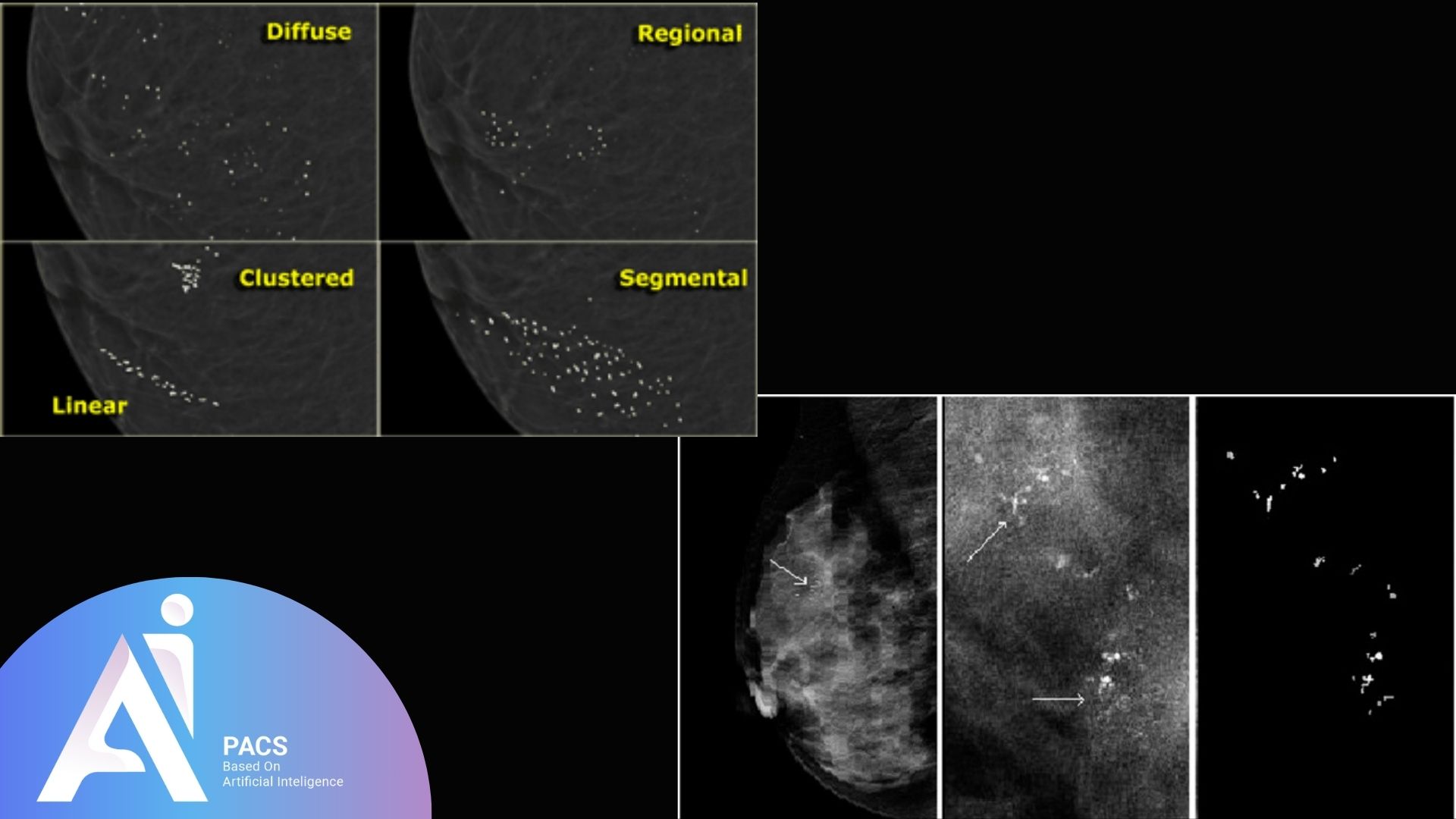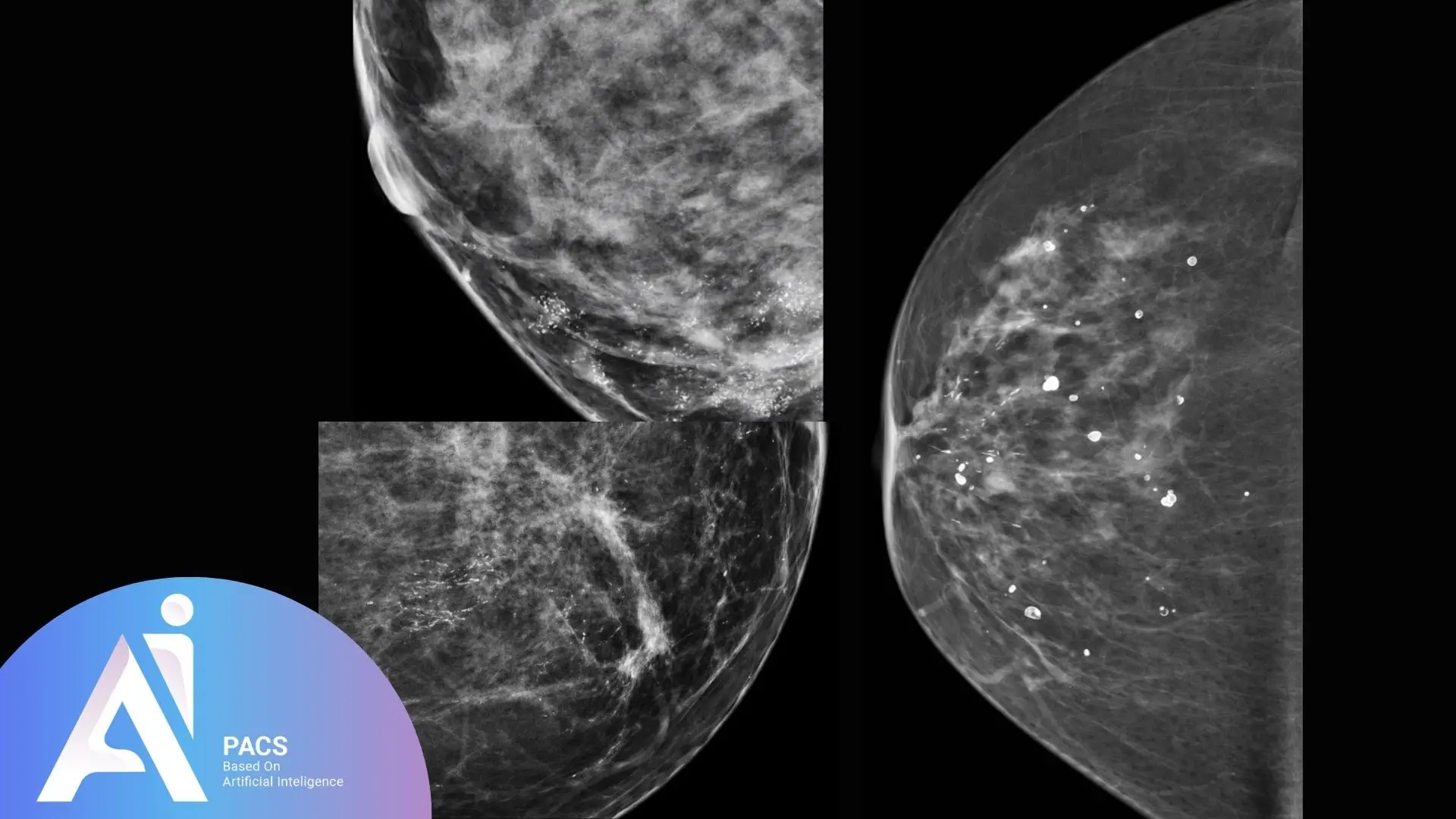What are microcalcifications?
Microcalcifications are tiny deposits of calcium that form within breast tissue. These specks are often too small to feel during a physical exam but can be detected through imaging. While most microcalcifications are benign, specific patterns may indicate underlying conditions, including early signs of breast cancer.
Why are they detected during mammograms?
Mammograms are susceptible imaging tools designed to detect subtle changes in breast tissue, including microcalcifications. The high-resolution images reveal these calcium deposits, allowing radiologists to evaluate their patterns and identify potential abnormalities that may require further investigation.

Types of Microcalcifications
Microcalcifications can be classified based on appearance, pattern, and clinical significance. Understanding these categories helps determine whether they are harmless or require further investigation.
Benign microcalcifications
Benign microcalcifications are typically associated with non-cancerous changes in breast tissue. These may result from aging, past injuries, fibrocystic changes, or calcification of milk ducts. They often appear as round, scattered, or evenly distributed specks on a mammogram and usually pose no threat.
Suspicious or malignant microcalcifications
Suspicious microcalcifications may suggest abnormal changes, such as ductal carcinoma in situ (DCIS) or invasive breast cancer. These often appear in clusters or irregular patterns and may vary in shape and size. Their presence frequently prompts additional imaging or a biopsy for accurate diagnosis.
📁 If your mammogram shows microcalcifications, it’s essential to understand their significance. Upload your report now for a detailed expert review and next steps.
Critical differences in patterns and appearance
The appearance and arrangement of microcalcifications play a crucial role in determining their significance:
- Benign: Scattered, round, or smooth-edged deposits.
- Suspicious: Tight clusters, linear patterns, or irregular shapes.
Radiologists analyze these differences using the BI-RADS system to decide if further testing is needed.
Causes of Microcalcifications
Microcalcifications in the breast can arise from various causes, most of which are benign. Common causes include natural aging processes, where calcium deposits form in milk ducts or breast tissue. Other benign conditions, such as fibrocystic changes, past injuries, or inflammation, can also lead to their development. In some cases, microcalcifications may signal ductal carcinoma in situ (DCIS), a non-invasive form of breast cancer, or other early malignancies. Factors like previous radiation therapy, calcified cysts, or residual calcifications from healing processes can also contribute. While most microcalcifications are harmless, their appearance and patterns are closely analyzed to rule out underlying issues.
How Microcalcifications Are Evaluated
Microcalcifications are evaluated using advanced imaging techniques to determine their nature and significance. Radiologists focus on their size, shape, distribution, and pattern to assess whether they are benign or suspicious, guiding further diagnostic steps if necessary.
Mammogram techniques for detecting microcalcifications
Mammograms are the primary tool for detecting microcalcifications. High-resolution digital mammography allows radiologists to identify even the most minor calcium deposits. Specialized techniques like magnification views are often used to provide a closer, more detailed look at the microcalcifications, enabling a better assessment of their characteristics.
BI-RADS classification and its role
The BI-RADS (Breast Imaging Reporting and Data System) classification is a standardized tool radiologists use to describe mammogram findings, including microcalcifications. This system assigns a category that indicates the likelihood of malignancy, ranging from benign (BI-RADS 1 or 2) to highly suspicious (BI-RADS 4 or 5). BI-RADS helps guide the following steps: monitoring, additional imaging, or biopsy.
Factors considered by radiologists
Radiologists consider several factors when evaluating microcalcifications:
- Pattern and distribution: Clustered or linear patterns may suggest malignancy.
- Size and shape: Irregular shapes or varying sizes can raise concerns.
- Density: High-density calcifications may warrant further investigation.
These factors, combined with a patient’s medical history and any additional imaging findings, help radiologists make informed decisions about the need for further tests or interventions.

When Are Microcalcifications a Concern?
Microcalcifications become a concern when their patterns, distribution, or characteristics suggest the possibility of underlying abnormalities, such as ductal carcinoma in situ (DCIS) or invasive breast cancer. Suspicious microcalcifications often appear in tight clusters, linear arrangements, or branching shapes and may vary in size and density. Unlike benign calcifications, which are typically scattered and uniform, these patterns prompt further investigation, including additional imaging or a biopsy. While not all suspicious microcalcifications indicate cancer, their detection and careful evaluation are crucial for early diagnosis and treatment.
Treatment and Follow-Up
Proper management of microcalcifications depends on their nature. They can range from benign findings requiring no treatment to precancerous or cancerous conditions needing intervention. Regular follow-up and monitoring play a crucial role in ensuring breast health.
Managing benign microcalcifications
Benign microcalcifications typically do not require treatment. These calcium deposits usually result from aging, previous injuries, or harmless tissue changes. Radiologists may recommend regular mammograms to monitor these findings over time and ensure no changes in their pattern or appearance.
Treating precancerous or cancerous findings
When microcalcifications are identified as precancerous or indicative of breast cancer, prompt treatment is essential. Options may include a biopsy to confirm the diagnosis, followed by procedures like lumpectomy, mastectomy, or radiation therapy, depending on the extent of the condition. Early intervention for ductal carcinoma in situ (DCIS) or other malignancies often results in favorable outcomes.
Importance of regular mammograms for monitoring
Regular mammograms are vital for monitoring any changes in microcalcifications over time. These screenings allow radiologists to detect new patterns or suspicious developments early, significantly improving the chances of identifying and treating breast abnormalities before they progress. Consistent follow-up ensures long-term breast health and peace of mind.
Preventive Measures and Risk Reduction?
While it’s not always possible to prevent the formation of microcalcifications, adopting a proactive approach to breast health can help reduce risks and detect issues early. Maintaining a healthy lifestyle, including a balanced diet of antioxidants and calcium-regulating nutrients, may contribute to overall breast tissue health. Regular physical activity and avoiding smoking can also lower the risk of conditions associated with abnormal calcifications. Routine mammograms and clinical breast exams are essential for early detection of any changes in breast tissue, allowing for timely intervention. Women with a family history of breast cancer or other risk factors should discuss personalized screening plans with their healthcare provider to stay vigilant and reduce their long-term risk.
Conclusion
Microcalcifications on a mammogram are small but significant markers that can indicate various breast tissue changes, ranging from harmless to potentially severe. Understanding their types, causes, and evaluation methods helps demystify their role in breast health. While most microcalcifications are benign, specific patterns may signal the need for further investigation, underscoring the importance of early detection through routine mammograms. With proper evaluation, timely treatment, and regular follow-up, women can manage their breast health effectively and reduce the risk of complications. Proactive measures and ongoing vigilance remain crucial to maintaining long-term breast wellness.
👉 Don’t wait for changes in your breast health. Upload your mammogram images or report for AI-PACS expert analysis and take the first step toward ensuring your long-term breast wellness.



